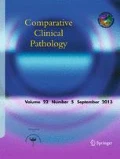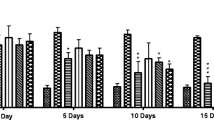Abstract
Helianthus annuus (sunflower) is an annual plant native to America that possesses a large inflorescence. The present study evaluated the acute toxicity, antidiabetic, oral glucose tolerance test (OGTT), and antioxidant effects of methanol extract of H. annuus leaves using alloxan-induced diabetic rats. The extract at the dose range of 300–3,600 mg/kg was tolerated by the rats. The extract (150, 300, and 600 mg/kg) showed a significant (p < 0.05) dose- and time-dependent decrease in blood glucose level of alloxan-induced diabetic rats. There was no significant (p > 0.05) differences between the extract-treated groups and glibenclamide (2 mg/kg)-treated groups. At 6 h posttreatment, there was a significant (p < 0.05) decrease in blood glucose level at 600 mg/kg (66.74 %) extract compared with the negative control group (10 mg/kg distilled water). The OGTT in normoglycemic rat showed no significant (p > 0.05) difference in blood glucose level among the treatment groups. In diabetic OGTT, the blood glucose level of the extract (600 mg/kg)-treated group was significantly (p < 0.05) lower when compared to the that of the negative control group at 120 min post glucose load, but there was no significant (p > 0.05) difference between the extract- and glibenclamide (2 mg/kg)-treated groups. The extract produced a concentration-dependent increase in antioxidant activity. These findings suggest that H. annuus has potent antidiabetic and antioxidant activities and validate its folkloric use in traditional medicine for the treatment of diabetes mellitus.




Similar content being viewed by others
References
Achretar S, Kaklij GS, Pote MS, Kelka SM (1991) Hypoglycemic activity of Eugenia jambolana and Ficus bengalensis: mechanism of action. In-vivo 5:143–147
Anaga AO, Asuzu IU (2010) Antihyperglycaemic properties of the ethyl acetate extract of Dennettia tripetala in normal and diabetic rat. J Compl Integr Med 34:239–244
Atawodi SE (2011) Evaluation of the hypoglycaemic, hypolipidemic and antioxidant effects of methanolic extract of “Ata-Ofa” polyherbal tea (A-polyherbal) in alloxan-induced diabetic rats. Drug Invention Today 3:270–276
Ayebe EK, Yapi HF, Edjeme AA et al (2012) In vivo, in vitro antioxidant activity assessment & acute toxicity of aqueous extract of Cola nitida (Sterculiaceae). Asian J Biochem Pharm Res 2(4):144–155
Bakirel T, Bakirel U, Keles OÜ, Ülgen SG, Yardibi H (2008) In vivo assessment of antidiabetic antioxidant activities of rosemary (Rosmarinus officinalis) in alloxan-diabetic rabbits. J Ethnopharmacol 116:64–73
Benzie FF, Strain JJ (1999) Ferric reducing/antioxidant power assay: direct measure of total antioxidant activity of biological fluids and modified version for simultaneous measurement of total antioxidant power and ascorbic acid concentration. Meth Enzymol 299:15–23
Bergman EN (1993) Disorders of carbohydrate and fat metabolism. In: Swenson JM, Reece DW (eds) Dukes physiology of domestic animal, 11th edn. Canstock Publishing Associate, London, pp 499–501
Bruneton J (1995) Pharmacognosy, phytochemistry, medicinal plants (trans: Hatton CK), 2nd edn. Lavoisier Publishing, Paris, p 55
Chethan KM, Gowda TV (2010) Sunflower (Helianthus annuus L.) petals: a new biological source of lutein. Res J Pharm Biol Chem Sci 1(4):438–448
Dewanjee S, Bose SK, Sahu R, Mandal SC (2008) Anti-diabetic effect of matured fruits of Diospyros peregrina in alloxan-induced diabetic rats. Int J Green Pharm 2:95–99
DHHS (1985) Guide for the care and use of laboratory animals. Institute of Laboratory Animal Resources Commission on Life Sciences. National Research Council. National Academy, Washington, D.C
DiStefano JK, Watanabe RM (2010) Pharmacogenetics of anti-diabetes drugs. Pharmaceuticals 3:2610–2646
Foster DW (1996) Diabetes mellitus. In: Isselbacher KJ, Brawnwald E, Wilson JD, Martin JB, Fauci AS, Kasper DL (eds) Harrison's principle of internal medicine. McGraw-Hill, New York, pp 1979–1981
Glore S, Van Treeck D, Knehans AW, Guild MF (1994) Soluble fiber and serum lipids: a literature review. J Am Diet Assoc 94:425–436
Hofsø D, Jenssen T, Hager H, Røislien J, Hjelmesaeth J (2010) Fasting plasma glucose in the screening for type 2 diabetes in morbidly obese subjects. Obes Surg 20:302–307
Iwalewa EO, Adewale IO, Aiwo BJ, Arogundabe T, Osinowo A, Daniyan OM, Adetogun GE (2008) Effects of Harungana madagascariensis stem bark extract on the antioxidant markers in alloxan induced diabetic and carrageenan induced inflammatory disorders in rats. J Compl Integr Med 5(1):1–18
Kamalakannan N, Prince PSM (2006) Antihyperglycaemic and antioxidant effect of rutin, a polyphenolic flavonoid, in streptozotocin-induced diabetic Wistar rats. Basic Clin Pharmacol Toxicol 98:97–103
Kamtchouing P, Kahpui SM, Diomeni-Dzeufiet PD, Tedoug L, Asongalem EA, Dimo T (2005) Anti-diabetic activity of methanol/methylene chloride stem bark extract of Terminalia superba and Canarium schweinfurthii on streptozotocin-induced diabetic rats. J Ethnopharmacol 105:306–309
Lewi DM, Hopp HE, Escandon AS (2006) Sunflower (Helianthus annuus L.). Methods Mol Biol 343:291–298
Madubunyi II, Onoja SO, Asuzu IU (2012) In vitro anti-oxidant and in vivo anti-diabetic potentials of the methanol extract of Ficus glumosa Del (Moraceae) stem bark in alloxan-induced diabetic mice. J Comp Clin Pathol 21:389–394
Mensor LL, Fabio SM, Gilda GL, Alexandre SR, Tereza CD, Cintia SC, Suzana GL (2001) Screening of Brazilian plant extracts for antioxidant activity by the use of DPPH free radical method. Phytother Res 15:127–130
Mitscher IA, Rao GSR, Veysoglu T, Drake S, Haas T (1983) Isolation and identification of trachyloban-19-oic and (−)-kaur-16-en-19-oic acids as antimicrobial agents from the prairie sunflower, Helianthus annuus. J Nat Prod 46:745–746
Mohammadi J, Naik PR (2008) Evaluation of hypoglycaemic effect of Morus alba in an animal model. Indian J Pharmacol 40:15–18
Nelson DL, Cox MM (2006) Lehninger, principles of biochemistry, 5th edn. Saunders, New York, p 307
Nelson RW (2000) Diabetes mellitus. In: Ettinger SJM, Feldman EC (eds) The textbook of veterinary internal medicine: diseases of the dog and cat. Saunders, Philadelphia, pp 1563–1591
OECD (2001) Guidelines for the testing of chemicals /section 4: health effects test no. 423: acute oral toxicity—acute toxic class method. Organization for Economic Cooperation and Development, Paris
Olaijide OA, Awe SO, Mekinde JM, Morebise O (1999) Evaluation of the antidiabetic property of Morinda lucida leaves in streptozotocin-diabetes rats. J Pharm Pharmacol 51:1321–1324
Prince PSM, Moon VP (2000) Hypoglycemic and other related action of Tinospora cordifolia roots in alloxan-induced diabetic rats. J Ethnopharmacol 70:19–25
Sekudelski T (2001) The mechanism of alloxan and streptozotocin action in B cells of the rat pancreas. Physiol Res 50:536–546
Selvan VT, Manikandan L, Senthil KGP, Suresh R, Kakoti BB, Gomathi P, Kumar DA, Saha P, Gupta M, Mazumder UK (2008) Antidiabetic and antioxidant effects of methanol extract of Artanema sesamoides streptozotocin-induced diabetic rats. Intl J Appl Res Nat Prod 1:25–33
Sepici-Dincel A, Açikgöz Ş, Çevik C, Sengelen M, Yeşilada E (2007) Effects of in vivo antioxidant enzyme activities of myrtle oil in normoglycaemic and alloxan diabetic rabbits. J Ethnopharmacol 110:498–503
Sood R (2006) Textbook of medical laboratory technology, 1st edn. Jaypee Brothers Medical Publishers Ltd., New Delhi, pp 598–608
Soon YY, Tan BKH (2000) Evaluation of hypoglycaemic and antioxidant activities of Morinda officinalis in streptozotocin-induced diabetic rats. Singap Med J 43(2):077–085
Stevens PF (2001) Angiosperm phylogeny website version 9, June 2008. http://www.mobot.org/mobot/research/apweb/welcome.html. Accessed 21 Dec 2012
Trease GE, Evans WC (2002) Pharmacognosy, 15th edn. Saunders, London, pp 58–302
Wild S, Roglic G, Green A, Sicree R, King HO (2004) Global prevalence of diabetes: estimate for the year 2000 and projection for 2030. Diabetes Care 27(5):1047–1053. http://care.diabetesjournals.org.cgi/content/full/27/5/1047
World Health Organization (1980) The WHO Expert Committee on Diabetes Mellitus. Technical report series. World Health Organization, Geneva
World Health Organization (2006) Definition and diagnosis of diabetes mellitus and diabetes care intermediate hyperglycemia: report of a WHO/IDF consultation. WHO, Geneva
Acknowledgments
We are grateful to Mr. A. O. Ozioko for the identification of the plant material. The authors are very grateful to the management of Science Education Post Basics (STEP-B) project UNN, for providing some materials required for this work.
Conflict of interest
The authors report no conflict of interest. The authors alone are responsible for the content and writing of this paper.
Author information
Authors and Affiliations
Corresponding author
Rights and permissions
About this article
Cite this article
Onoja, S.O., Anaga, A.O. Evaluation of the antidiabetic and antioxidant potentials of methanolic leaf extract of Helianthus annuus L. on alloxan-induced hyperglycemic rats. Comp Clin Pathol 23, 1565–1573 (2014). https://doi.org/10.1007/s00580-013-1824-3
Received:
Accepted:
Published:
Issue Date:
DOI: https://doi.org/10.1007/s00580-013-1824-3




